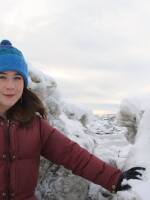Researchers with ADF&G and the USFWS say that the number of wolves hunting on the Nushagak Peninsula is dependent on the caribou population. The wolves do not cause the caribou population to fluctuate.
For about a decade, the U.S. Fish and Wildlife Service and Alaska Department of Fish and Game have been studying wolves on the Togiak National Wildlife Refuge. In 2007, these agencies set out to answer the question, what effect does wolf predation have on the Nushagak Peninsula caribou population? In February, the TNWR organized a lecture where refuge supervisory biologist, Patrick Walsh, presented the study findings to the Dillingham community.
The study began when the Nushagak Peninsula caribou herd declined in the early 2000s, limiting hunting opportunities.
“People were not very happy, and there were calls for wolf control,” said Walsh.
Biologists had rarely observed wolves on the peninsula, so the devised a study to test the concern that wolves were killing too many caribou.
“My impression was, yeah, wolves go there, but not very much. They pretty much stay away from the peninsula and are probably no factor for caribou at all,” said Walsh.
From 2007 to 2012, researcher’s radio collared 19 wolves. They tracked the wolves’ locations and observed their habits remotely as well as in the field.
The results surprised researchers. They found that one wolf pack in particular used the peninsula extensively.

“They used every bit of the peninsula during this study. So what were they doing on the peninsula? Well, they were preying on caribou,” Walsh said.
Though researcher’s initial hypothesis that wolves rarely ventured onto the Nushagak Peninsula was wrong, the evidence suggests that they were correct that wolves did not cause the caribou populations’ decline.
During the course of the study, the caribou population increased dramatically, and as the caribou population increased, the number of wolves on the Nushagak Peninsula increased as well.
“Logic can tell you that the caribou population didn’t go up because wolf predation increased. Wolf predation increased because the caribou population went up. So this being the case, this is not a wolf-controlled system. This is a caribou-controlled system that wolves are taking advantage of,” Walsh concluded.
Put simply, more wolves focus their hunting efforts on the Nushagak Peninsula when caribou are readily available. Caribou numbers are responsible for how many wolves spend time on the peninsula. Wolves do not cause the caribou population to fluctuate.
ADF&G and the USFWS are still studying wolves in the Togiak National Wildlife Refuge. Their current study examines wolf and bear predation on moose.
Contact the author at avery@kdlg.org or 907-842-5281.



